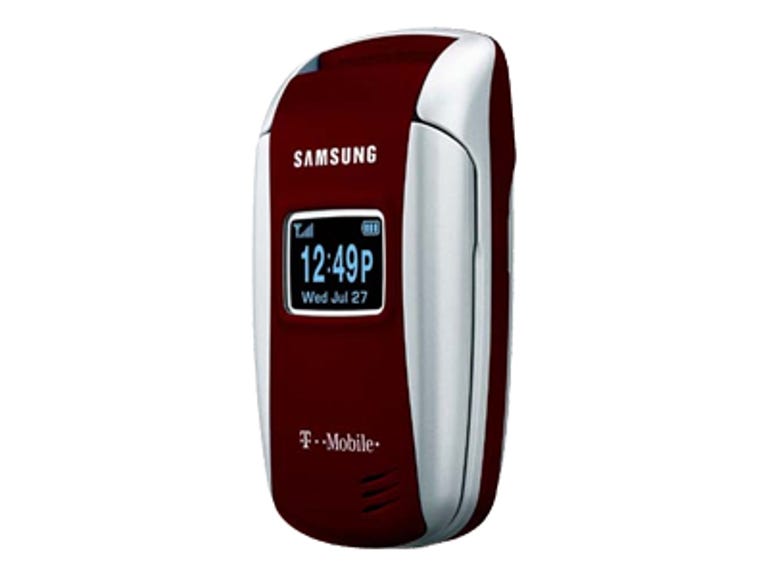Samsung churns out another simple cell phone with the new SGH-T209 for T-Mobile. Modeled after the Samsung SGH-X495, it retains the same basic features and overall design but ditches the white color scheme in favor of two differently hued versions: silver and candy-apple red. Like the SGH-X495, the SGH-T209 offers a sleek if relatively staid design and a low-range feature set that includes a speakerphone and instant messaging. Although it's a tad expensive if you pay the full price of $119, service rebates will lower it to a more reasonable $19.
The Good
The Bad
The Bottom Line

The Samsung SGH-T209 has exactly the same dimensions as its predecessor (5.5 by 1.9 by 1.0 inches), but it weighs slightly more, at 3.3 ounces. The SGH-T209 also inherits the same body design; it's relatively sleek with rounded edges and no external antenna, but the overall look is rather dull. The candy-apple-red version, however, is definitely appealing. The SGH-T209 takes its external display cues from the SGH-X495's. The postage-stamp-size screen is monochrome, but it shows useful information, such as the date, the time, battery life, signal strength, and caller ID (where available). However, we don't like the fact that you can't change the backlighting time on the screen. When the backlighting goes off, the time can be difficult to read, and you must open the phone to make the screen active again. Beneath the display is a small grille for the speakerphone, which marks another difference; the SGH-X495 also has a speakerphone, but it's inside the handset.
Inside the Samsung SGH-T209 is a 1.75-inch, 128x160-pixel screen that shows 65,000 colors. It's no different from most Samsung displays in that it's bright and vibrant, but it can be too bright at times, and it's difficult to see in direct sunlight. Still, it does a serviceable job and works well for scrolling through the menus. You can adjust the brightness, the contrast, the backlighting time, and the font color. Below the display are the standard Samsung navigation keys, which consist of a five-way toggle, two soft keys, the Talk and End/power buttons, and a Clear key. The keys are easy to use, and the toggle acts as a shortcut to the messaging menu, instant messaging, the voice recorder, and the phone book. The pill-shaped keypad buttons are also typical of handsets of this caliber. They're decently sized, and they're lit by a bright backlight, but they're flush with the surface of the phone. The only external features are a volume rocker and a headset jack on the left spine.
The Samsung SGH-T209's feature set is basic, but it should please most cell phone users. The 500-contact phone book has room in each entry for five phone numbers and an e-mail address; the SIM card can hold an additional 250 names. You can organize contacts into caller groups, but in a change from the SGH-X495, individual groups can be paired with one of 20 polyphonic ring tones, 10 of which are MegaTones. You can also assign groups a picture, but since there's no camera, you'll have to be creative. In any case, the image won't show up on the external display.
As for other features, you get a vibrate mode; Yahoo, ICQ, and AOL instant messaging; an alarm clock; a calculator; a calendar; a to-do list; 1-minute voice memos; text and multimedia messaging; a timer; a stopwatch; and a unit converter for length, weight, volume, and temperature. We were glad to see that Samsung threw in a speakerphone, but you can turn it on only after you've made a call. Overall, the SGH-T209 has 3MB of shared memory.
You can personalize the Samsung SGH-T209 with a variety of wallpaper, messaging tones, and display patterns. If you're bored with those, you can download more options from T-Mobile via the WAP 2.0 wireless Web browser. You get two Java (J2ME) games--SnowBallFight and BubbleSmile--but more titles are available if you want them.
We tested the dual-band (GSM 850/1800/1900; GPRS) Samsung SGH-T209 in San Francisco using T-Mobile's service. Call quality was good overall and somewhat better than that of the SGH-X495. Voice quality was clear, but volume was a tad low; users with hearing impairments should test the SGH-T209 before buying. Callers could tell we were using a cell phone, but they reported no significant problems on their end. It's worth noting, however, that when using automated phone services such as an airline-reservation number, we had to speak loudly to be understood. Speakerphone calls had more volume and were clearer than on the SGH-X495, due to the external position of the speaker. The SGH-T209 has a promised talk time of 5 hours and a rated standby time of eight days. Our tests revealed a talk time of 4 hours, 30 minutes and a standby time of eight and a half days. According to FCC radiation tests, the Samsung SGH-T209 has a digital SAR rating of 1.29 watts per kilogram.



